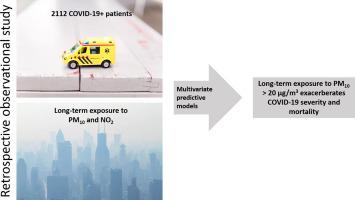Environment International ( IF 10.3 ) Pub Date : 2021-10-16 , DOI: 10.1016/j.envint.2021.106930 Montse Marquès 1 , Eudald Correig 2 , Daiana Ibarretxe 3 , Eva Anoro 4 , Juan Antonio Arroyo 5 , Carlos Jericó 6 , Rosa M Borrallo 7 , Marcel la Miret 8 , Silvia Näf 9 , Anna Pardo 10 , Verónica Perea 11 , Rosa Pérez-Bernalte 12 , Rafael Ramírez-Montesinos 13 , Meritxell Royuela 14 , Cristina Soler 15 , Maria Urquizu-Padilla 16 , Alberto Zamora 17 , Juan Pedro-Botet 18 , , Lluís Masana 3 , José L Domingo 1

|
Background
Age, sex, race and comorbidities are insufficient to explain why some individuals remain asymptomatic after SARS-CoV-2 infection, while others die. In this sense, the increased risk caused by the long-term exposure to air pollution is being investigated to understand the high heterogeneity of the COVID-19 infection course.
Objectives
We aimed to assess the underlying effect of long-term exposure to NO2 and PM10 on the severity and mortality of COVID-19.
Methods
A retrospective observational study was conducted with 2112 patients suffering COVID-19 infection. We built two sets of multivariate predictive models to assess the relationship between the long-term exposure to NO2 and PM10 and COVID-19 outcome. First, the probability of either death or severe COVID-19 outcome was predicted as a function of all the clinical variables together with the pollutants exposure by means of two regularized logistic regressions. Subsequently, two regularized linear regressions were constructed to predict the percentage of dead or severe patients. Finally, odds ratios and effects estimates were calculated.
Results
We found that the long-term exposure to PM10 is a more important variable than some already stated comorbidities (i.e.: COPD/Asthma, diabetes, obesity) in the prediction of COVID-19 severity and mortality. PM10 showed the highest effects estimates (1.65, 95% CI 1.32–2.06) on COVID-19 severity. For mortality, the highest effect estimates corresponded to age (3.59, 95% CI 2.94–4.40), followed by PM10 (2.37, 95% CI 1.71–3.32). Finally, an increase of 1 µg/m3 in PM10 concentration causes an increase of 3.06% (95% CI 1.11%-4.25%) of patients suffering COVID-19 as a severe disease and an increase of 2.68% (95% CI 0.53%-5.58%) of deaths.
Discussion
These results demonstrate that long-term PM10 burdens above WHO guidelines exacerbate COVID-19 health outcomes. Hence, WHO guidelines, the air quality standard established by the Directive 2008/50/EU, and that of the US-EPA should be updated accordingly to protect human health.
中文翻译:

长期接触高于 WHO 指南的 PM10 会加剧 COVID-19 的严重程度和死亡率
背景
年龄、性别、种族和合并症不足以解释为什么有些人在感染 SARS-CoV-2 后仍然没有症状,而另一些人则死亡。从这个意义上说,正在调查长期暴露于空气污染造成的风险增加,以了解COVID-19感染过程的高度异质性。
目标
我们的目的是评估长期暴露于 NO 2和 PM 10对 COVID-19 严重程度和死亡率的潜在影响。
方法
对 2112 名 COVID-19 感染患者进行了回顾性观察研究。我们建立了两组多变量预测模型来评估长期暴露于 NO 2和 PM 10与 COVID-19 结果之间的关系。首先,通过两个正则化逻辑回归,将死亡或严重 COVID-19 结果的概率预测为所有临床变量以及污染物暴露的函数。随后,构建了两个正则化线性回归来预测死亡或重症患者的百分比。最后,计算优势比和效应估计。
结果
我们发现,在预测 COVID-19 严重程度和死亡率时,长期暴露于 PM 10是比一些已经说明的合并症(即:慢性阻塞性肺病/哮喘、糖尿病、肥胖)更重要的变量。PM 10对 COVID-19 严重程度的影响估计最高(1.65,95% CI 1.32-2.06)。对于死亡率,最高影响估计对应于年龄(3.59,95% CI 2.94–4.40),其次是 PM 10(2.37,95% CI 1.71–3.32)。最后, PM 10浓度每增加 1 µg/m 3,导致患 COVID-19 严重疾病的患者增加 3.06% (95% CI 1.11%-4.25%),并增加 2.68% (95% CI 1.11%-4.25%) 0.53%-5.58%)的死亡。
讨论
这些结果表明,长期 PM 10负担高于 WHO 指南会加剧 COVID-19 健康结果。因此,世界卫生组织指南、2008/50/EU指令制定的空气质量标准以及美国环保局的空气质量标准应相应更新,以保护人类健康。











































 京公网安备 11010802027423号
京公网安备 11010802027423号